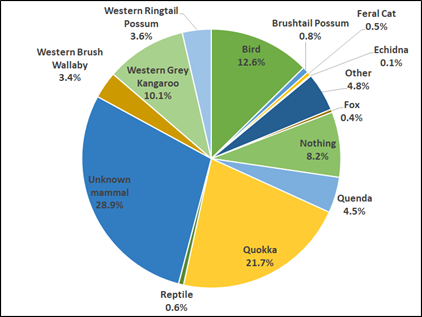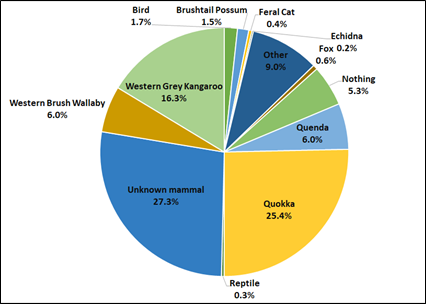Finished! Looks like this project is out of data at the moment!
Thanks everyone for their effort in analysing the camera data here on the South Coast; the support has been overwhelming! Please be patient with us whilst we are working in the background to get gather the next season of data (eta mid/late summer 2025).
Results
South Coast Threatened Fauna Recovery Project Zooniverse report – 2023
Thanks to every one of the 2,696 registered volunteers who contributed to the 417,332 classifications of our first data set. We uploaded 40,065 subject sets of the wonderful wildlife that occurs in the conservation reserves managed by the Department of Biodiversity, Conservation and Attractions on the south coast of Western Australia. In this first year of the South Coast Threatened Fauna Recovery Project being partnered with Zooniverse, data images from Two Peoples Bay Nature Reserve and Waychinicup National Park were processed, and in the next period we will be including images from Cape Arid National Park and Nuytsland Nature Reserve.
We have finally finished vetting all the images you have helped to identify, and the quokka has come out on top! Quokka were the most common species in front of the camera, appearing in nearly 22% of the identifications at Two Peoples Bay (Figure 1) and 25% at Waychinicup (Figure 2). Below are two graphs (Figures 3 and 4) showing the mean daily detection rates of quokka for the data processed to date (July 2019 – May 2021 for Two Peoples Bay, and October 2020 – June 2021 for Waychinicup), with this increase in detection suggesting our intensive invasive predator management is having a positive effect on the prevalence of one of Western Australia’s unique endemic threatened species.

Figure 1: Summary of the percentage of subjects by taxonomic group at Two Peoples Bay Nature Reserve.

Figure 2: Summary of the percentage of subjects by taxonomic group at Waychinicup National Park.

Figure 3: Mean daily detection rates of quokka (Setonix brachyurus) on the 1km camera grid in in Two Peoples Bay (±SD).

Figure 4: Mean daily detection rates of quokka (Setonix brachyurus) on the 1km camera grid in in Waychinicup (±SD).
Not only are quokka one of the cheekiest mammals in front of the camera, it seems they are also one of the trickiest to identify. In 6% of the images the quokka was mistakenly identified as Gilbert’s potoroo! Whilst our citizen scientists haven’t found a rare Gilbert’s potoroo in this set of data, we are hopeful someone may come across one soon.
Some species can be extremely difficult to identify, even for experienced scientists. Especially, when the photo only contains a fraction of an ear or tip of a tail. The considerable percentage of unidentified species at both sites is testament to that struggle. For future identification, try using the wooden stake in the image to help estimate size (it sits 30cm out of the ground) and study up on the different sizes and proportions of key identifying features for some of the more common mammals on the South Coast.
And the birds
When designing this project, we were keen to make sure that birds captured in camera images were identified to species level, and to do this we had the support of some remarkable photographers who provided the images in the user guide. As a result, the identification of birds was comprehensive. 12.6% of the images processed for Two Peoples Bay were birds, 9.5% were successfully identified to species level. A total of 41 species of birds were captured on the cameras, including threatened species like the Noisy Scrub-bird (Atrichornis clamosus), Western Bristlebird (Dasyornis longirostris) and Carnaby’s Black Cockatoo (Zanda latiorstris).
Whilst Western Australia’s rarest mammal and bird weren't detected in any of the data upload in this round of data; we are busy behind the scenes preparing the next lot of data to be uploaded; with the aim of getting images from Cape Arid National Park and Nuystland Nature Reserve online soon.
Invasive Predators – the red fox and feral cat
A major aim of these camera monitoring grids is to keep track on the changes in feral predator populations over time within critical habitat for the suite of South Coast threatened animals we are trying to protect. Data collected confirms that the intensive invasive predator management is having a positive impact on predator numbers, as mean daily detection rates have remained low (Figures 5-8). This is a positive sign that control methods (baiting and trapping during this reporting period) are maintaining a low invasive predator density, which in turn has a positive effect on the native species in these important conservation reserves.

Figure 5: Mean daily detection rates of feral cat (Felis catus) on the 1km camera grid in in Two Peoples Bay (±SD).

Figure 6: Mean daily detection rates of red fox (Vulpes vulpes) on the 1km camera grid in Two Peoples Bay (±SD).

Figure 7: Mean daily detection rates of feral cat (Felis catus) on the selected cameras for Zooniverse 1km camera grid in in Waychinicup (±SD).

Figure 8: Mean daily detection rates of red fox (Vulpes vulpes) on the selected 1km camera grid in Waychinicup (±SD).
Snapshot of the statistics for images processed in year one of the Zooniverse platform:
All:
Subject sets: 40,133
Total number of classifications: 420,123
Average number of IDs per subject: 2.50 (±0.007 SE)
Maximum number of IDs for one subject set: 14
Two Peoples Bay Nature Reserve:
Date range: July 2019 – May 2021
Number of cameras: 15
Subject sets: 20, 833
Total number of classifications: 216,501
Average number of IDs per subject: 2.51 (±0.009 SE)
Maximum number of IDs for one subject set: 14
Waychincup -Manypeaks
Date range: October 2020 - June 2021
Number of cameras: 10
Subject sets: 19,300
Total number of classifications: 184,768
Average number of IDs per subject: 2.49 (±0.009 SE)
Maximum number of IDs for one subject set: 9
Acknowledgements:
Purchase of camera traps was supported by the Friends of the Western Ground Parrot and Gilbert’s Potoroo Action Group, and servicing of cameras assisted by volunteers.
A huge thank you to the moderators who have helped answer your queries: this includes Jacky Courtenay and Leigh Whisson from the Gilbert’s Potoroo Action Group, Anne Bondin, Liz Tanner and Paul Wettin.
Graphs of daily detection rates were produced in the R- Shiny app for processing images, developed by Mark Cowan, DBCA.